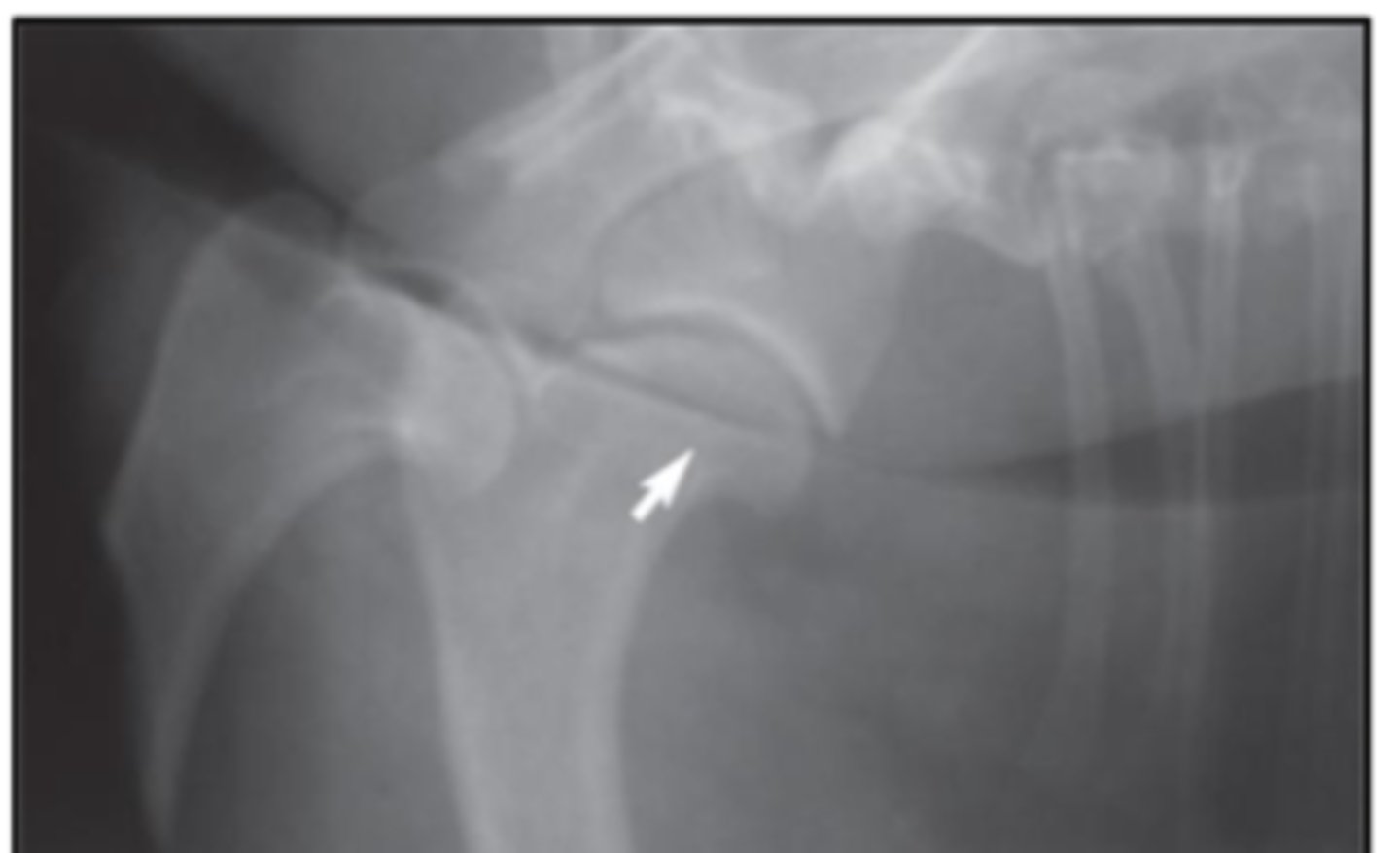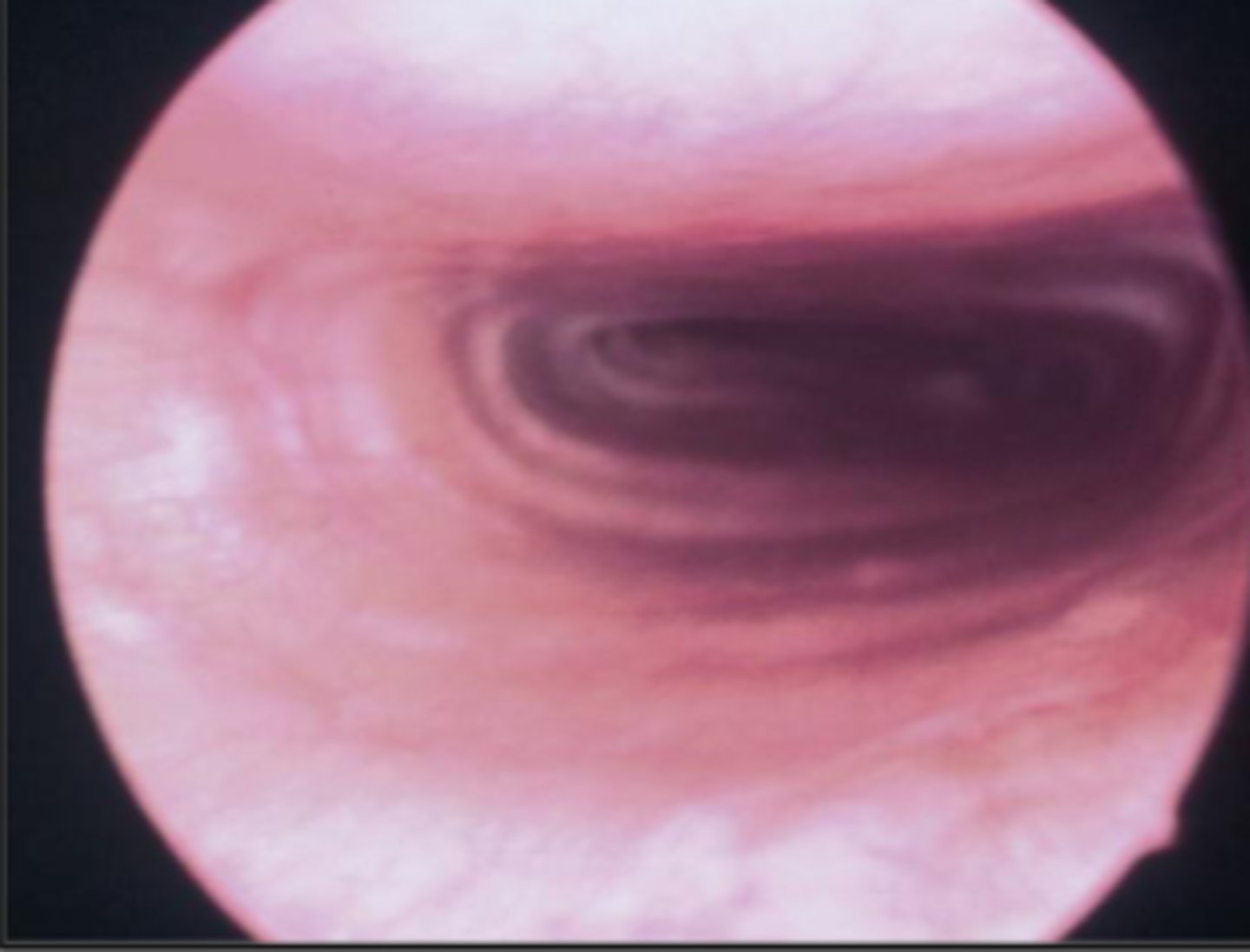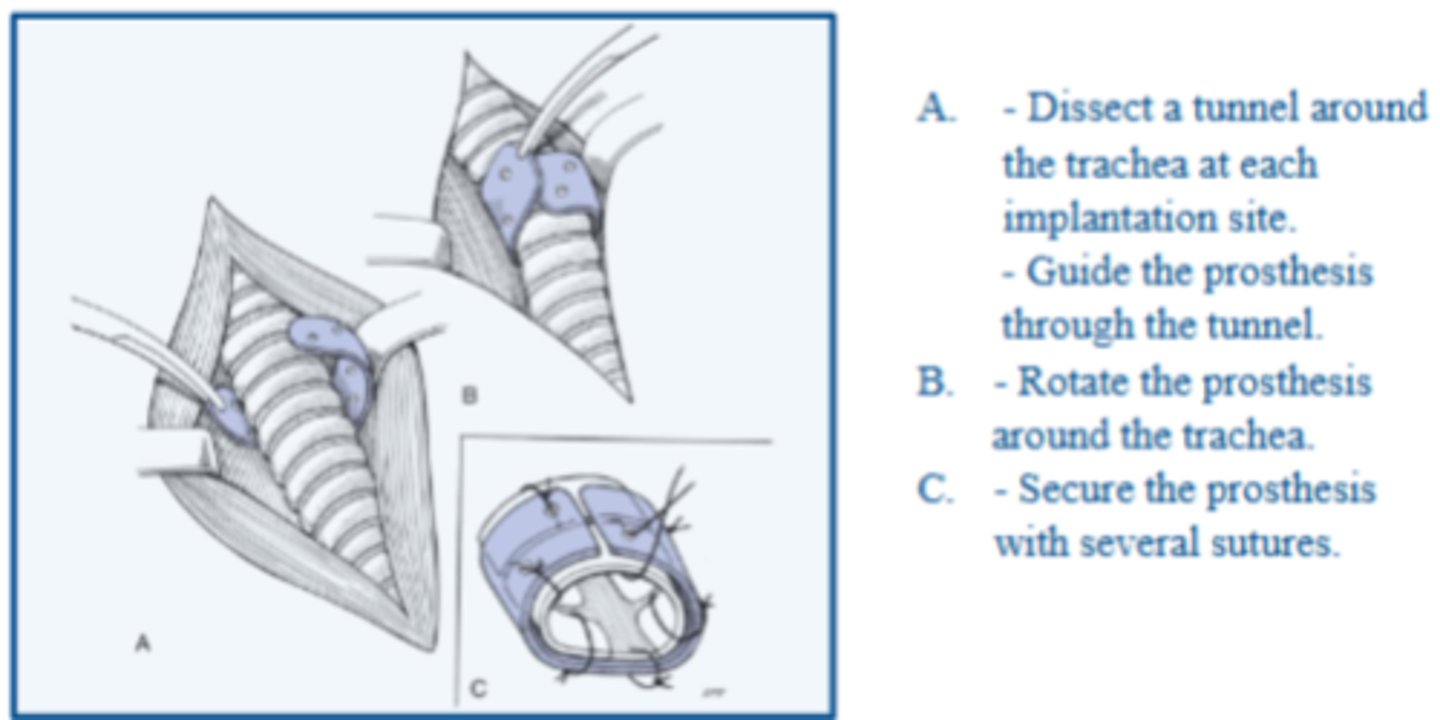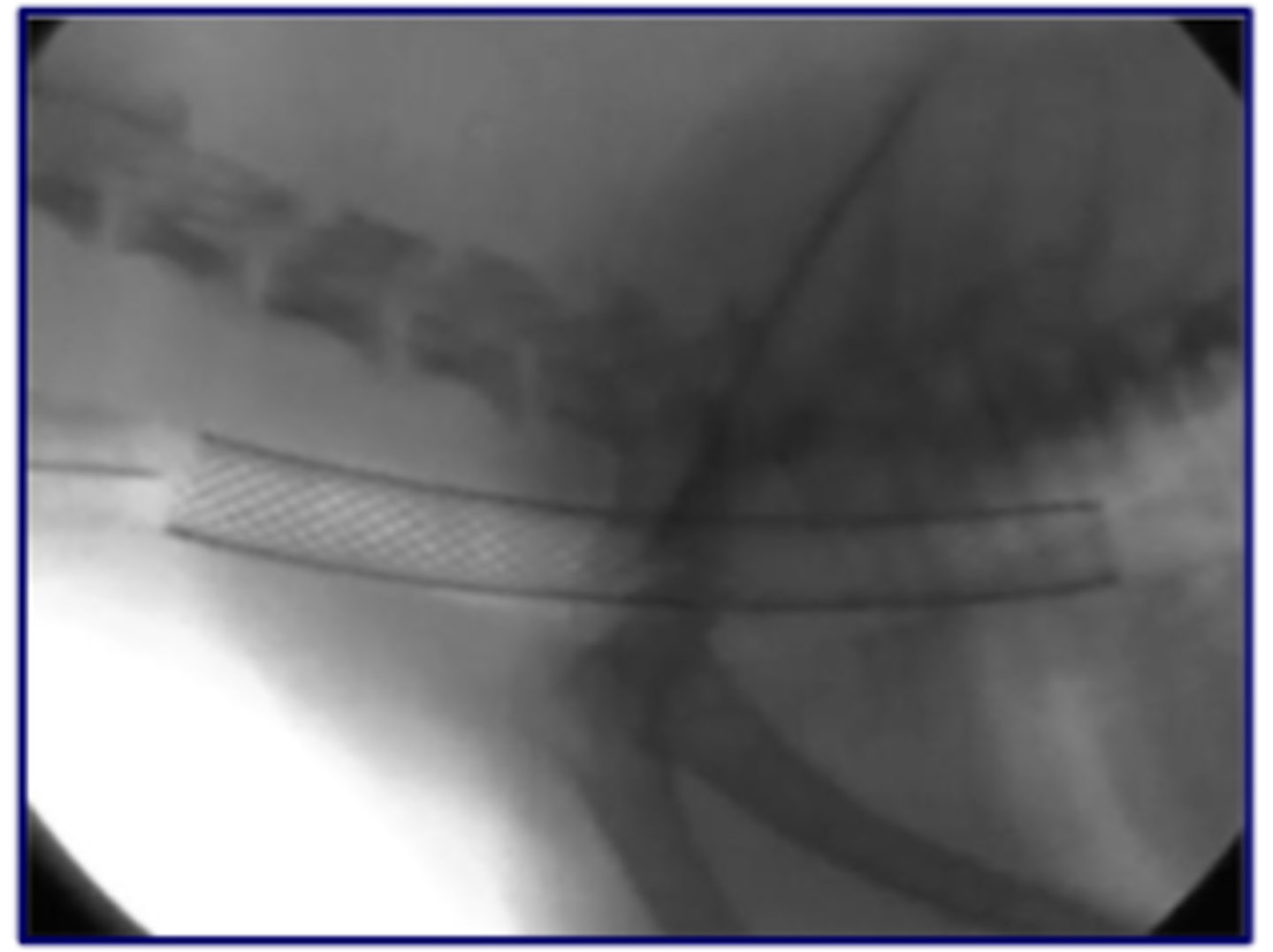✅️12 - Tracheal Collapse 🟢
1/76
There's no tags or description
Looks like no tags are added yet.
Name | Mastery | Learn | Test | Matching | Spaced |
|---|
No study sessions yet.
77 Terms
cartilage flaccidity and flattening
Tracheal Collapse (“Collapsing Trachea”) is a form of tracheal obstruction caused by _____
FYI: Sometimes erroneously referred to as Congenital Tracheal Stenosis in older literature
1. Genetic Factors
2. Nutritional Factors
3. Allergens
4. Neurologic Deficiency
5. Small Airway Disease
6. Degeneration of Cartilage Matrices
Cause of tracheal collapse is unknown and probably multifactorial.
What are some proposed causes?
fibrocartilage; collagen
With tracheal collapse, hyaline cartilage replaced by _____ and _____ fibers
tracheal conformation
With tracheal collapse, cartilages lose rigidity and ability to maintain normal _____ during the respiratory cycle
true
T/F - Tracheal collapse may be confined to an isolated segment or may involve the entire trachea and bronchial tree
dorsoventral
Tracheal collapse typically occurs in a _____ direction.
Lateral collapse has been reported
inspiration; expiration
With tracheal collapse, the cervical and thoracic inlet collapse on [inspiration/expiration].
Intrathoracic collapses on [insipiration/expiration]
thoracic
_____ inlet is most susceptible to tracheal collapse
lumen size
Collapse reduces the _____ and interferes with airflow to the lungs
1. abnormal respiratory noises
2. exercise intolerance
3. gagging
4. varying degrees of dyspnea
What are some things we may see in a patient with tracheal collapse?
tracheobronchial clearing
Coughing becomes an important _____ mechanism
toy- and miniature-breed dogs
•Toy Poodles
• Yorkshire Terriers
• Pomeranians
• Maltese
• Chihuahuas
Tracheal collapse typically occurs in what type of dogs?
yes
Are males and females affected by tracheal collapse equally?
trauma; deformity; intraluminal or extraluminal masses
Tracheal collapse in larger dogs usually associated with _____, _____, or _____ or _____ and should not be equated with tracheal collapse in toy-breed dogs
6-8
Tracheal collapse classily described as occurring in middle-aged or older toy breeds - average _____ years
6 months; 5 years
Tracheal collapse is frequently diagnosed in dogs with respiratory problems between _____ and _____ of age
1. Respiratory Noise
2. Dyspnea
3. Exercise Intolerance
4. Cyanosis
5. Syncope
With tracheal collapse, we see onset of clinical signs often before 1 year.
It often progresses with age and is associated with.....
true
T/F - Some dogs with tracheal collapse never suffer respiratory distress, while others die of asphyxiation
obese
Clinical signs of tracheal collapse more severe in _____ animals
1. Wheezing
2. Hacking
3. Coughing
4. Stridorous Breathing
What are some respiratory noises associated with tracheal collapse?
Some dogs do not make abnormal respiratory noises
productive; nonproductive
Cough associated with tracheal collapse can be _____ or _____
goose honk
Cough associated with tracheal collapse is classically a "_____" cough
paroxysmal
Coughing associated with tracheal collapse often becomes cyclic and
_____
50
Gagging after coughing may occur in as many as _____% of cases of tracheal collapse
1. Tracheal Infection
2. Tracheal Compression
3. Exercise
4. Excitement
5. Eating
6. Drinking
7. Hot, humid weather
8. Noxious stimuli (i.e., smoke and other respiratory irritants) may also precipitate clinical signs
Signs of tracheal collapse may be elicited or exacerbated by..
1. Almost 50% of dogs are obese
2. Laryngeal paresis or paralysis has been reported in 20% to 30%
3. Systolic heart murmur consistent with mitral valve insufficiency in 1/3.
4. Enlarged left atrium putting pressure on the carina and mainstem bronchi may aggravate upper respiratory signs
5. ≥ 40% of dogs thought to have dental or periodontal disease
6. Hepatomegaly and Hepatopathy are common
What are some concurrent problems seen with tracheal collpase?
oral bacteria
Aspiration of _____ into diseased airways is hypothesized to contribute to exacerbation of clinical signs of tracheal collapse caused by increased airway inflammation or increased coughing
1. Flaccid tracheal cartilages with prominent lateral borders on palpation of the cervical trachea.
2. Paroxysmal Coughing on palpation
3. Abnormal respiratory noises (on auscultation)
4. Mitral valve disease (on auscultation)
5. Soft end-expiratory snapping together of the tracheal wall (intrathoracic tracheal collapse) (on auscultation)
6. Abnormal heart sounds associated with concurrent cardiac disease (on auscultation)
What are some PE findings with tracheal collapse?
inspiratory & expiratory lateral
_____ radiographs of neck and thorax diagnostic in ~ 60% of patients with severe tracheal collapse (>50% of the lumen).
inspiration
Cervical trachea expected to collapse on [inspiration/expiration]
expiration
Thoracic trachea expected to collapse on [inspiration/expiration]
cardiomegaly; bronchiectasis
Thoracic radiographs often reveal _____ & pulmonary disease.
_____ on 30% of thoracic radiographs.
reviewed
Review: Lateral radiograph of a 2-year-old Yorkshire Terrier with Tracheal Collapse (arrow) at the Thoracic Inlet

fluoroscopy
• Facilitates evaluation of dynamic movement
• Finds many cases missed by survey radiographs
• Will miss collapse of the trachea in the lateral dimension
bronchoscopy
Diagnostic Imaging may require multiple imaging modalities as well as _____
laryngeal paralysis or collapse is present in approximately 30% of dogs with tracheal collapse
Laryngoscopy should usually be done at the same time as tracheoscopy. Why?
1. Confirm and grade the severity of collapse
2. Evaluate the entire Tracheobronchial Tree
3. Collect airway samples for cytology & culture
4. Confirm location of collapse
What is done during a Tracheoscopy/Bronchoscopy?
1
Grade _____ Tracheal Collapse:
-Relatively normal tracheal cartilage anatomy
-Redundant dorsal tracheal membrane decreases luminal diameter up to 25%
2
Grade _____ Tracheal Collapse:
-Mild to moderate flattening of tracheal cartilages
-50% loss of luminal diameter
3
Grade _____ Tracheal Collapse:
-Severe flattening of tracheal cartilages
-75% loss of luminal diameter
4
Grade _____ Tracheal Collapse:
-Complete obstruction
-Tracheal lumen is obliterated
reviewed
Review: Endoscopic view of a grade III dorsoventral tracheal collapse

true
T/F - With tracheal collapse, hematologic & serum biochemistry usually normal or insignificant
50
Positive tracheobronchial cultures > _____%
1. Sinus Arrhythmia
2. Cor Pulmonale (right-sided heart failure)
3. Left Ventricular Enlargement
What may an ECG reveal?
1. Brachycephalic Syndrome
2. Tonsillitis
3. Laryngeal Collapse
4. Laryngeal Paralysis
5. Bronchitis
6. Tracheobronchitis
7. Tracheal Neoplasia or Mass
8. Allergies
9. Heartworm Disease
10. Pulmonary Disease
11. Cardiac Disease
12. Hypoplastic Trachea
13. Tracheal Stenosis (congenital vs acquired)
What are some differential diagnosis we should consider?
mild; < 50
Medical management recommended for animals with _____ clinical signs & for those with _____% collapse - results in improvement in clinical signs in most dogs
weight loss
What is critical for management of tracheal collapse?
1. Harness instead of a collar
2. Nonsmoking atmosphere
3. Management of concurrent underlying conditions
What are some environmental modifications for tracheal collapse?
1. Antitussives
2. Antibiotics
3. Bronchodilators
4. +/- Anti-inflammatory agents
Medical therapy includes.....
dyspneic
Severely _____ patients may require sedation & supplemental oxygen
aerosolized bronchodilators (i.e.,albuterol); corticosteroids
Pediatric metered dose inhalers used with spacers and face masks may be used in cooperative dogs to administer _____ and _____
mucolytics; saline nebulization
_____ and _____ may benefit those with excess mucus production and infection
true
T/F - Response to medical therapy is usually transient, and the disease typically progresses
1. Dogs with moderate to severe clinical signs
2. ≥ 50% reduction of the tracheal lumen
3. Refractory to medical therapy
Surgery treatment for tracheal collapse is recommended for.....
1. Laryngeal Paralysis or Collapse
2. Generalized cardiomegaly
3. Bronchial Collapse
4. Chronic Pulmonary Disease,
5. Collapsed Mainstem Bronchi
Poor surgical candidates include dogs with.....
to support the tracheal cartilages and trachealis muscle while preserving as much of the segmental blood and nerve supply to the trachea as possible
What is the goal of tracheal collapse surgery?
1. Extraluminal Ring Prostheses
2. Endoluminal Stenting
What are the tracheal collapse surgical techniques?
1. Observed closely before surgery for signs of progressive dyspnea
2. Intraoperative Prophylactic Antibiotics
3. Pretreat with anti-inflammatory dose of glucocorticoid (e.g., dexamethasone sodium phosphate 0.1–0.5 mg/kg IV) in small patients (< 2-4 kg) to minimize tracheal mucosal swelling
What are some pre-operative management things to consider?
lateral pedicles
The segmental blood and nerve supply to the trachea travels in the _____ on each side of the trachea
minimal mobilization of the trachea
_____ is necessary to maintain a good blood supply after surgery
lateral pedicle; carotid sheath
The left recurrent laryngeal nerve is located in the _____.
The right is sometimes located within the _____.
1. Dorsal Recumbency
2. Neck extended & elevated over a pad (to deviate the trachea ventrally).
3. The caudal mandibular area, ventral neck, and cranial thorax should be clipped and prepared for aseptic surgery
Describe patient positioning for Extraluminal Ring Prosthesis
Extraluminal Ring Prosthesis
What is shown and described here?

Endoluminal Stent Placement
Minimally invasive technique used for intraluminal prosthesis placement varies with the type of self-expanding elastic implant selected
-General anesthesia using tracheoscopy or fluoroscopy
-Selection of implant size must be accurate
10 mm
Endoluminal Stent Placement
Implant should remain approximately _____ from the larynx and the carina to prevent excess irritation and granulation
early fracture of the stent
Endoluminal Stent Placement
If the stent is near the thoracic inlet, constant movement at that point often leads to _____
open-looped or knitted
Endoluminal Stent Placement
_____ implants are preferred because they promote coverage of the stent with tracheal epithelium
Endoluminal Stent Placement
What was done here?
Radiographic appearance of a 2-year-old Yorkshire Terrier

1. Continuous monitoring during recovery
2. Acute respiratory distress may occur
3. Nasal insufflation of oxygen
4. Anti-inflammatory dose of glucocorticoids may be beneficial in animals with edema and inflammation
5. Mucolytics and saline nebulization for those with severe inflammation
6. Antibiotics continued for 7 to 10 days if bacterial tracheitis is present
7. Antitussives, bronchodilators, analgesics, and sedatives prn to control coughing and excitement
8. Cage rest for 3 to 7 days then gradually increase
9. Tracheoscopy recommended 1 to 2 months after surgery & later if respiratory signs deteriorate.
10. Immediate improvement in clinical signs may be seen with both extraluminal and endoluminal stents
11. Coughing and lack of marked improvement in clinical signs should be expected
12. Significant clinical improvement within 2 to 3 weeks of surgery
Describe post-op care and assessment
true
T/F - Some animals have nearly complete remission of clinical signs after surgery. Others continue to have episodes of coughing or other respiratory noises.
true
T/F - The quality of life is improved for most patients, but neither surgery nor stents cure the condition
1. Death
2. Coughing Bruising
3. Swelling
4. Recurrent laryngeal nerve damage result in
laryngospasm, laryngeal paresis, or paralysis
5. Tracheal Necrosis
6. Stent Migration
7. Granuloma Formation
8. Hemorrhage
9. Emphysema
10. Pneumomediastinum
11. Infection
12. Mucous Obstruction
13. Tracheal Rupture
14. Squamous metaplasia and ulceration of the tracheal epithelium
15. Implant Shortening
16. Implant fracture
17. Implant Collapse or Deformation
What are some complications of tracheal collapse surgery?
concurrent respiratory problems
The prognosis is more dependent on _____, such as laryngeal paralysis or collapse and bronchial disease, than on the location or severity of tracheal collapse
quite variable
Outcome studies are _____ with regard to extraluminal versus endoluminal stenting
shorter
Survival times in dogs receiving endoluminal stenting appear to be markedly [longer/shorter]
mainstem bronchi collapse
Regardless of treatment type, the presence of _____ is associated with shorter survival times